Is It Safe to Eat Burgers Medium Rare
Eating burgers medium rare isn't safe due to the high risk of bacterial contamination in ground beef. Unlike steaks, where bacteria primarily reside on the surface, ground beef mixes potential pathogens throughout the meat. To eliminate dangerous bacteria like E. coli and Salmonella, you must cook burgers to an internal temperature of 160°F (71°C). Undercooked burgers can lead to severe foodborne illnesses, especially for vulnerable groups like children, the elderly, and pregnant women. While restaurants may have strict controls in place, it's best to err on the side of caution when preparing burgers at home. You'll discover that there are techniques to keep your burgers juicy while ensuring they're fully cooked.
This post may contain affiliate links. If you make a purchase through these links, I may earn a commission at no additional cost to you. Additionally, portions of this post may be generated using artificial intelligence (AI) technology. While we strive for accuracy, please be aware that AI-generated content may not always be perfect and should be fact-checked when necessary.
The Spatula Scoops
- Eating medium rare burgers carries significant health risks due to potential bacterial contamination throughout the ground beef.
- The FDA recommends cooking ground beef to an internal temperature of 160°F (71°C) to ensure safety.
- Vulnerable populations, including children, elderly, and immunocompromised individuals, should avoid undercooked ground beef entirely.
- Restaurant controls and high-quality meat sourcing may reduce risks, but cannot eliminate them completely.
- Cooking techniques like sous vide or using a meat thermometer can help achieve safe, juicy burgers without compromising flavor.
Ground Beef vs. Steak Safety
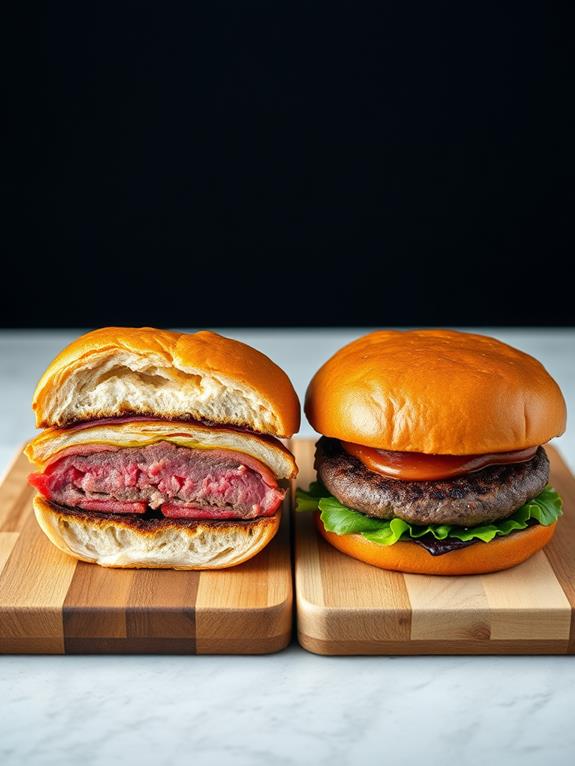
When you're craving a juicy burger, you might wonder why you can't order it medium rare like a steak. The answer lies in the fundamental differences between ground beef and whole cuts of meat when it comes to food safety. Ground beef poses a higher risk of contamination compared to steak due to the grinding process. While harmful bacteria typically reside on the surface of whole cuts, grinding distributes these pathogens throughout the meat. This means that when you cook a steak, searing the exterior can effectively kill surface bacteria, allowing for safe consumption even when rare. However, with ground beef, you need to cook it thoroughly to eliminate potential pathogens mixed throughout. Products like the Pyrex measuring cups can help accurately measure ingredients for your burger recipes.
To guarantee safety, you must cook ground beef to an internal temperature of at least 160°F (71°C). This temperature kills harmful bacteria like E. coli and Salmonella, which can cause foodborne illnesses. Health organizations, including the USDA, strongly advise against eating medium rare burgers due to the increased risk of bacterial contamination. By following proper cooking guidelines, you can enjoy your burger while minimizing health risks associated with undercooked ground beef.
Risks of Undercooked Burgers
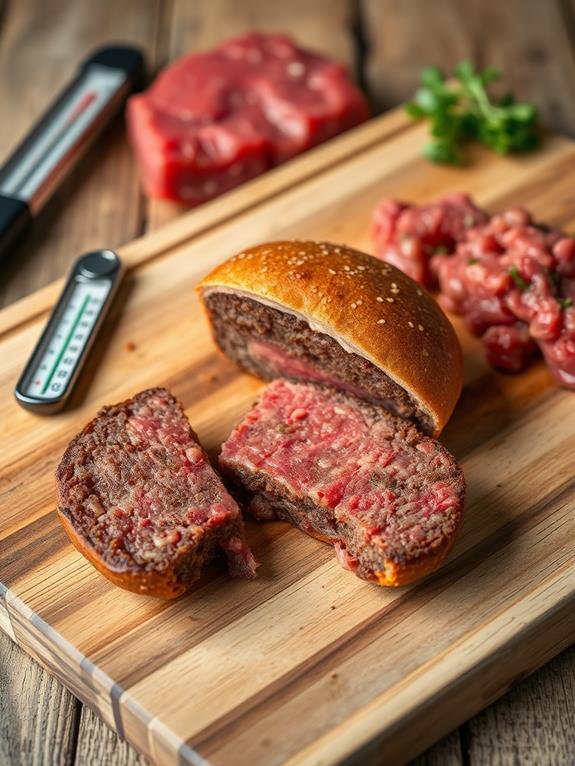
When you bite into an undercooked burger, you're taking a risk with your health. Medium-rare burgers can harbor dangerous bacteria like E. coli and Salmonella, which may lead to serious foodborne illnesses. In fact, it's crucial to verify that your food is prepared safely, just like how pet owners prioritize hydration with a reliable source such as a PetSafe Drinkwell Ceramic Pet Water Fountain. If you're in a vulnerable group, such as children, the elderly, pregnant, or immunocompromised, you should be especially cautious about consuming undercooked ground beef, as the health risks are even greater for you.
Foodborne Illness Dangers
The dangers of foodborne illness from undercooked burgers can't be overstated. When you consume medium rare burgers cooked below 140°F, you're putting yourself at risk of contracting Shiga toxin-producing E. coli (STEC). This bacteria can cause serious health issues, and the consequences can be severe.
Research has shown that if all burgers were served medium, approximately 5,370 annual illnesses could occur. However, if you fully cook your burgers, this number drops dramatically to just 178. That's a considerable difference in risk. The Finnish food safety agency, Ruokavirasto, advises against serving ground beef medium or less due to these E. coli infection risks.
Historical outbreaks, like the 2021 E. coli outbreak linked to undercooked burger patties, serve as stark reminders of the dangers associated with consuming burgers that aren't thoroughly cooked. To effectively eliminate harmful bacteria, you must cook ground beef to at least 160°F. This temperature guarantees that your burger is safe to eat, greatly reducing your risk of foodborne illness. Remember, when it comes to burgers, it's always better to prioritize safety over taste preferences.
Bacterial Contamination Risks
Delving deeper into the risks of undercooked burgers, it is vital to understand why ground beef poses a unique danger. Unlike whole cuts of steak, ground beef has a higher risk of bacterial contamination throughout the entire patty. This is because harmful bacteria, such as Shiga toxin-producing E. coli (STEC), can be mixed throughout the minced meat during processing.
When you're wondering if it is safe to eat medium rare burgers, consider this: cooking temperatures below 140°F aren't sufficient to kill these dangerous bacteria. The Finnish food safety agency, Ruokavirasto, warns that serving burgers medium or less can lead to approximately 5,370 annual illnesses based on their simulation data. To avoid food poisoning, it is imperative to cook your burgers to a safe internal temperature of at least 160°F.
Historical outbreaks linked to undercooked burger patties further illustrate the correlation between raw meat consumption and increased reports of foodborne illnesses. By ensuring your burgers are thoroughly cooked, you can dramatically reduce the risk of bacterial contamination and protect yourself from potential health hazards associated with consuming undercooked ground beef.
Vulnerable Population Concerns
Vulnerable populations face heightened risks when consuming undercooked burgers. If you're part of a group including children, the elderly, pregnant individuals, or those with weakened immune systems, you should be especially cautious about eating medium rare burgers. The Food Standards Agency advises these vulnerable populations to avoid undercooked ground beef due to the increased risk of foodborne illnesses.
Medium rare burgers, typically cooked below 140°F (60°C), can harbor dangerous bacteria like Shiga toxin-producing E. coli (STEC). For vulnerable groups, these pathogens pose considerable health risks. Research simulations suggest that if all burgers were served medium, there could be over 5,370 annual illnesses in Finland alone. This number starkly contrasts with the less than 300 reported STEC-related illnesses in 2022, highlighting the potential impact of proper cooking practices.
To protect yourself or vulnerable loved ones, it's essential to adhere to recommended safe cooking guidelines for ground beef. By ensuring burgers are thoroughly cooked, you can markedly reduce the risk of severe illness from harmful bacteria in undercooked meat.
Safe Cooking Temperatures
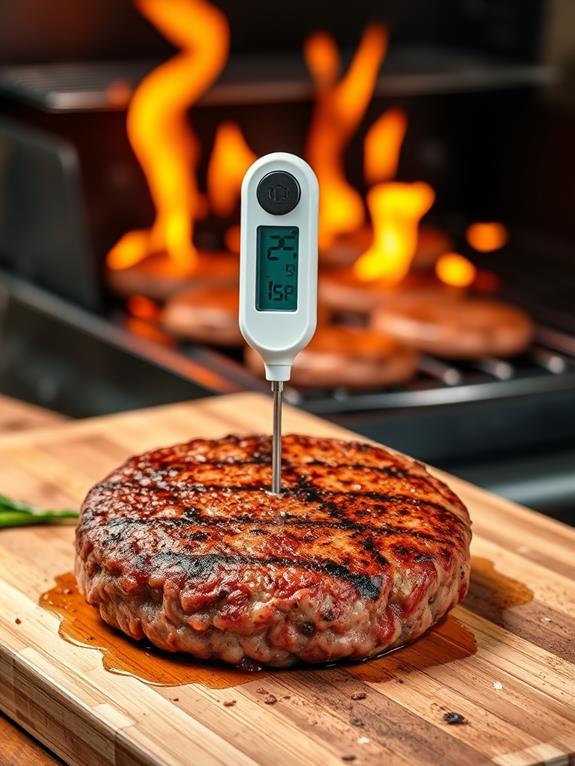
To guarantee your burgers are safe to eat, you'll need to cook them to the recommended internal temperature of 160°F (71°C). You can accurately measure this using an instant-read thermometer, such as the instant reading thermometer, inserting it into the thickest part of the patty. Remember, different time-temperature combinations can achieve the same safety level, such as 158°F (70°C) for two minutes or 176°F (80°C) for just six seconds.
Recommended Internal Temperatures
When it comes to safe cooking temperatures for burgers, food safety authorities have clear guidelines. You'll want to pay close attention to these recommended internal temperatures to guarantee your cooked meat is safe to eat. The USDA advises cooking ground beef to a minimum of 160°F (71°C), while the UK's Food Standards Agency recommends 70°C for two minutes. These temperatures are vital for eliminating harmful bacteria that may be present in ground beef.
It's important to note that medium-rare burgers, typically reaching only 130°F (54°C), don't meet these safety standards. While you might enjoy the juicier texture of a medium-rare burger, it's not worth the risk of foodborne illness. To prioritize food safety, you should use a meat thermometer to check the internal temperature of your burgers. If you're using alternative cooking methods like sous vide, you'll need to adjust cooking times to achieve pasteurization at lower temperatures. Remember, holding your burger at the recommended temperature for the appropriate time is key to guaranteeing it's thoroughly cooked and safe to eat.
Temperature Measurement Techniques
Knowing the recommended temperatures for safe burger cooking is only half the battle. You'll need to master temperature measurement techniques to guarantee your burgers are safe to eat. The most reliable method is using a food thermometer, specifically an instant-read type like a Thermapen. Insert it into the thickest part of the patty to get an accurate reading of the internal temperature.
Here's a quick guide to temperature measurement techniques:
| Method | Accuracy | Ease of Use |
|---|---|---|
| Instant-read thermometer | High | Easy |
| Color check | Low | Moderate |
| Touch test | Low | Difficult |
| Time-based cooking | Moderate | Easy |
| Sous vide | High | Complex |
Time-Temperature Relationships
Understanding time-temperature relationships is vital for safe burger cooking. When it comes to ground beef, the USDA recommends an internal temperature of 160°F (71°C) to eliminate harmful bacteria. This is notably higher than the temperature typically reached in medium rare burgers, which is around 130°F (54°C). At this lower temperature, dangerous bacteria like E. coli and Salmonella can survive.
To guarantee your burgers are safe to eat, you'll need to use a food thermometer to check the internal temperature. Simply cooking for a set time isn't enough, as temperatures can vary based on factors like meat thickness and grill heat. For effective pasteurization, you should hold the meat at a safe temperature for a specific duration. For example, cooking to 140°F (60°C) for 12 minutes can also make the meat safe.
While safe cooking temperatures may differ globally, many regions agree on 160°F (71°C) as the benchmark for ground beef safety. Remember, accurate measurement is vital. By cooking your burgers to the right temperature for the appropriate time, you'll guarantee that harmful bacteria are killed, making your food safe to eat.
Restaurant Practices and Precautions
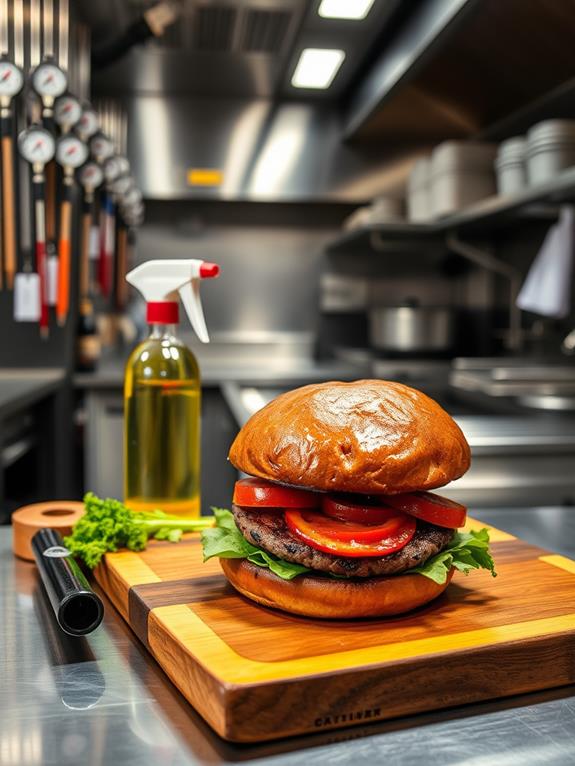
In light of the ongoing debate about medium-rare burgers, restaurants have implemented various practices and precautions to balance customer preferences with food safety concerns. Many establishments now employ strict controls to mitigate bacteria risk associated with undercooked burgers. These measures include sourcing high-quality meat and conducting pathogen tests to guarantee safety.
You'll find that restaurant practices vary globally. Some regions, like the UK, allow rare burgers if they're sourced and minced on the same day. However, food safety agencies still advise vulnerable groups, such as children and the elderly, to avoid consuming undercooked burgers.
When you visit a restaurant, you'll often see information about the risks of eating undercooked meat. This transparency helps you make informed decisions about your meal. Despite these precautions, there's a growing trend towards promoting fully cooked options due to increased awareness of bacteria like E. coli and salmonella.
As a customer, you should be aware that while some restaurants take extensive measures to serve medium-rare burgers safely, there's always a level of risk involved. It's vital to evaluate your health status and personal risk tolerance when ordering.
Cooking Methods for Juicy Burgers
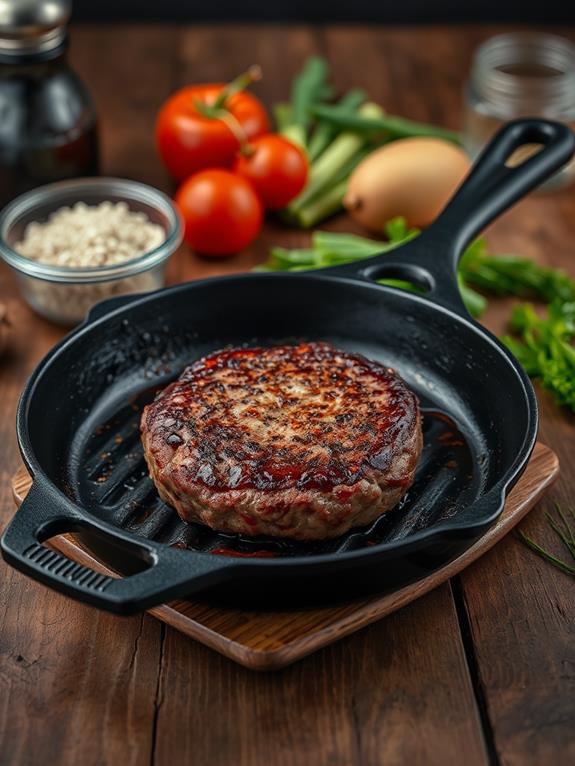
Achieving juicy burgers while guaranteeing food safety is a culinary balancing act. You'll want to cook your burgers to a minimum internal temperature of 160°F (71°C) to kill harmful bacteria like E. coli and Salmonella. This temperature is higher than what you'd use to eat rare meat, but it's necessary for ground beef.
To keep your burgers juicy, try incorporating an ice chip into larger patties. This creates steam during cooking, helping retain moisture. Another technique is to flip your burgers only once, which prevents the loss of natural juices. You can also create a divot in the center of the patty to prevent puffing and guarantee even cooking.
If you're looking for a more precise method, sous vide cooking offers a safe way to prepare juicy burgers. You can cook them at lower temperatures, like 135°F (57°C), for an extended period before giving them a quick sear for a flavorful crust. This method allows you to achieve a more tender texture while still guaranteeing food safety.
Food Safety Guidelines and Recommendations
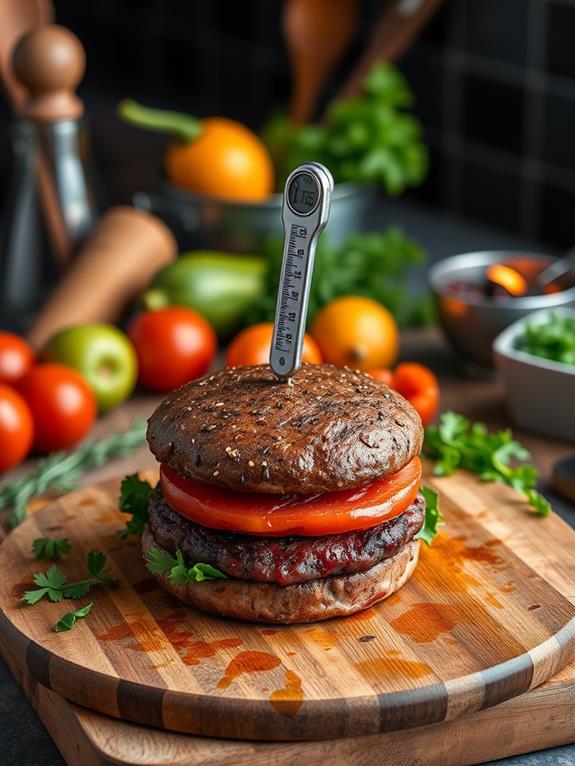
Food safety guidelines for burgers are clear and stringent. You'll find that the USDA recommends cooking ground beef to a minimum internal temperature of 160°F (71°C) to eliminate harmful bacteria like E. coli and Salmonella. This temperature is essential for your safety, as it guarantees that any potential pathogens in the meat are destroyed.
When you eat medium-rare burgers, you're exposing yourself to risks involved with undercooked meat. The Food Standards Agency in the UK advises vulnerable groups, such as children, the elderly, and pregnant women, to avoid these undercooked burgers due to increased health risks.
Here's a breakdown of burger cooking temperatures and their safety levels:
| Temperature | Safety Level | Recommended for |
|---|---|---|
| 130°F (55°C) | Unsafe | Not recommended |
| 140°F (60°C) | Moderate risk | General population |
| 160°F (71°C) | Safe | Everyone |
| 165°F (74°C) | Very safe | High-risk groups |
To cook burgers safely, you should use a meat thermometer to verify they reach the recommended temperature throughout. By following these guidelines, you're not only complying with food safety regulations but also greatly reducing your risk of foodborne illnesses.
Frequently Asked Questions
Is It Okay to Eat a Medium Rare Burger?
No, it's not okay to eat a medium rare burger. You're risking your health by doing so. Ground beef needs to be cooked thoroughly to kill harmful bacteria like E. coli. Unlike steaks, burgers have bacteria mixed throughout the meat, not just on the surface. To be safe, you should cook your burger to an internal temperature of 71°C (160°F). This guarantees all bacteria are destroyed, protecting you from potential foodborne illnesses. Don't take chances with your health; always cook your burgers well-done.
Is It Okay to Eat a Hamburger That Is a Little Pink?
It's not recommended to eat a hamburger that's still pink inside. While you might enjoy the taste, it's a significant health risk. Ground beef can contain harmful bacteria throughout, unlike whole cuts. To guarantee safety, you should cook your burger until it reaches an internal temperature of 160°F (71°C). This eliminates dangerous microorganisms like E. coli. Remember, vulnerable groups like children, pregnant women, and the elderly are at higher risk from undercooked meat. Always prioritize food safety over taste preferences.
How Rare Is Too Rare for a Burger?
Imagine a burger as a tightrope walker; too rare, and it's a dangerous balancing act. For safety, you shouldn't eat a burger that's pink in the middle. The USDA recommends cooking ground beef to 160°F (71°C) internal temperature. This guarantees harmful bacteria like E. coli are eliminated. While some may prefer the taste of rarer burgers, it's not worth the risk. Remember, ground beef isn't like a steak; bacteria can be mixed throughout, making thorough cooking essential.
How to Safely Make a Medium Rare Burger?
To safely make a medium rare burger, you'll need to start with fresh, high-quality ground beef from a reputable source. Use a food thermometer to guarantee the internal temperature reaches at least 130°F. Consider sous vide cooking for precise temperature control. Chill the meat before grinding and blanch pieces for 30-60 seconds to reduce surface bacteria. Remember, medium rare burgers are best suited for healthy adults. Always prioritize food safety and proper cooking techniques to minimize risks.





